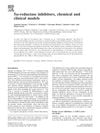Steroid 5α-Reductases and 3α-Hydroxysteroid Dehydrogenases: Key Enzymes in Androgen Metabolism
TLDR Key enzymes control androgen levels, affecting hormone activity and potential treatments.
The document discussed the roles of steroid 5α-reductases (5α-R) and 3α-hydroxysteroid dehydrogenases (3α-HSD) in androgen metabolism. In androgen target tissues like the prostate, type 2 5α-R converts testosterone to the potent androgen 5α-dihydrotestosterone (5α-DHT), which is then inactivated by reductive 3α-HSD to form the weaker androgen 3α-androstanediol. Conversely, oxidative 3α-HSD can regenerate 5α-DHT from 3α-androstanediol. These enzymes regulate the availability of androgens for the androgen receptor, influencing gene transcription. In peripheral tissues such as the liver, type 1 5α-R and reductive 3α-HSD work together to eliminate excess androgens. The distinct roles of these enzyme isoforms in anabolic and catabolic processes make them potential drug targets for treating androgen-dependent diseases.

